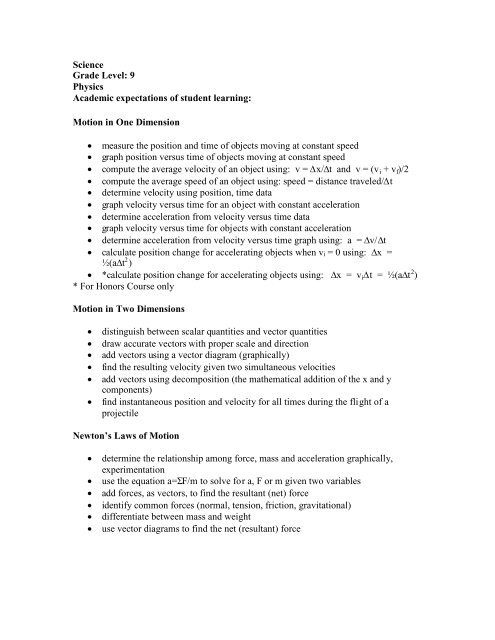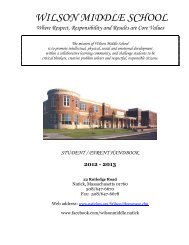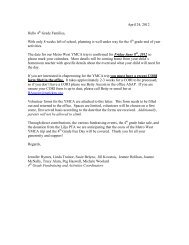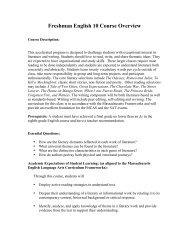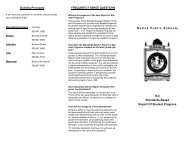Science Grade Level: 9 Physics Academic expectations of student ...
Science Grade Level: 9 Physics Academic expectations of student ...
Science Grade Level: 9 Physics Academic expectations of student ...
Create successful ePaper yourself
Turn your PDF publications into a flip-book with our unique Google optimized e-Paper software.
<strong>Science</strong><strong>Grade</strong> <strong>Level</strong>: 9<strong>Physics</strong><strong>Academic</strong> <strong>expectations</strong> <strong>of</strong> <strong>student</strong> learning:Motion in One Dimension measure the position and time <strong>of</strong> objects moving at constant speed graph position versus time <strong>of</strong> objects moving at constant speed compute the average velocity <strong>of</strong> an object using: v = ∆x/∆t and v = (v i + v f )/2 compute the average speed <strong>of</strong> an object using: speed = distance traveled/∆t determine velocity using position, time data graph velocity versus time for an object with constant acceleration determine acceleration from velocity versus time data graph velocity versus time for objects with constant acceleration determine acceleration from velocity versus time graph using: a = ∆v/∆t calculate position change for accelerating objects when vi = 0 using: ∆x =½(a∆t 2 ) *calculate position change for accelerating objects using: ∆x = v i ∆t = ½(a∆t 2 )* For Honors Course onlyMotion in Two Dimensions distinguish between scalar quantities and vector quantities draw accurate vectors with proper scale and direction add vectors using a vector diagram (graphically) find the resulting velocity given two simultaneous velocities add vectors using decomposition (the mathematical addition <strong>of</strong> the x and ycomponents) find instantaneous position and velocity for all times during the flight <strong>of</strong> aprojectileNewton’s Laws <strong>of</strong> Motion determine the relationship among force, mass and acceleration graphically,experimentation use the equation a=ΣF/m to solve for a, F or m given two variables add forces, as vectors, to find the resultant (net) force identify common forces (normal, tension, friction, gravitational) differentiate between mass and weight use vector diagrams to find the net (resultant) force
Circular Motion and UniversalGravitation solve for Fg given G, m1, m2, and r using: Fg = Gm1m2/r 2 Solve for G, m1, m2, or rgiven Fg and the other appropriate variables using: F g = Gm 1 m 2 /r 2 solve for Fc given m, v and r using: Fc = mv 2 /r solve for m, v or r given Fc and the other appropriate variables using: Fc = mv 2 /r *combine the relationships for F c and F g to solve for planetary motionEnergyHeat solve problems for simple machines (levers, pulley, ramps) using conservations <strong>of</strong>energy and the relationship: Work in = Work out know how to apply: ΣWork = K use a rollercoaster to show energy transforming from potential (U) to kinetic (K)and back use power to determine work from the relationship: P = work/time given work and time, determine power using the relationship: P = work/time determine the units for work, power and energy from measured SI units know heat is a form <strong>of</strong> energy and is measured in Joules know what specific heat is and know how to determine it from experimental data know what latent heat is and know how to determine it from experimental data use the relationship: Q = mc∆T to solve for energy, specific heat, mass ortemperature given three <strong>of</strong> the four variables use the relationship: Q = mL to solve for energy, mass or latent heat given two <strong>of</strong>the three variables *use the relationship: Q = mc∆T + mL graph temperature as a function <strong>of</strong> heat when mass is constant, then use the graphto determine specific heat, c, and latent heat, L know how the Celsius and Kelvin temperature scales are related and know how toconvert to Celsius from Kelvin and to Kelvin from Celsius know the relationship between temperature and thermal expansion <strong>of</strong> objectsElectric state that net charge can lead to force identify 3 ways to charge an object – friction, contact and induction state those circumstances under which charges attract or repel know that charge is the result <strong>of</strong> a gain/loss <strong>of</strong> electrons know that electric forces are many orders <strong>of</strong> magnitude greater than gravitationalforcesع1/4π *know the inverse square nature <strong>of</strong> the electric force, k =
apply Coulomb’s Law, F = kq 1 q 2 /r 2 , in order to determine the charge, force,distance and constant know the difference between electric force and electric field sketch an electric field for a simple arrangement <strong>of</strong> charges define electric current know that voltage is a measure <strong>of</strong> electric potential know that resistance impedes the flow <strong>of</strong> electric charge know the units for voltage, current and resistance know how to experimentally measure voltage and current know how to use experimental values <strong>of</strong> voltage and current to determineresistance know how to apply and when to apply Ohm’s Law, V = IR know how to solve for voltage, current or resistance using Ohm’s Law know the difference between series and parallel circuits know how to construct both series and parallel circuitsSimple harmonic motion waves and sound recognize simple harmonic motion and differentiate simple harmonic motion fromother types <strong>of</strong> motion state how simple harmonic motion leads to wave motion know units <strong>of</strong> speed, frequency and wavelength know how to solve for speed, frequency and wavelength using the wave equation identify how frequency, speed and wavelength <strong>of</strong> a wave are generated know how speed <strong>of</strong> a wave is determined by the medium through which it travels know how frequency <strong>of</strong> a wave is determined by the source from which it isgenerated know how the wavelength <strong>of</strong> a wave is determined by a combination <strong>of</strong> themedium through which it travels and the source from which it is generated draw diagrams <strong>of</strong> constructive interference and destructive interference draw diagrams <strong>of</strong> sound waves


